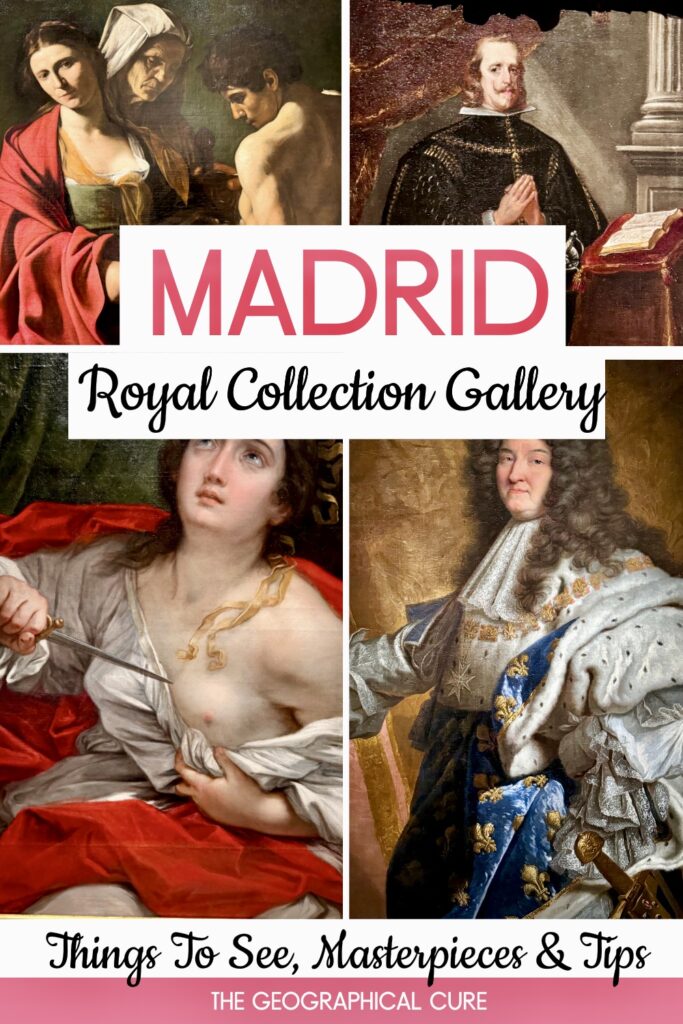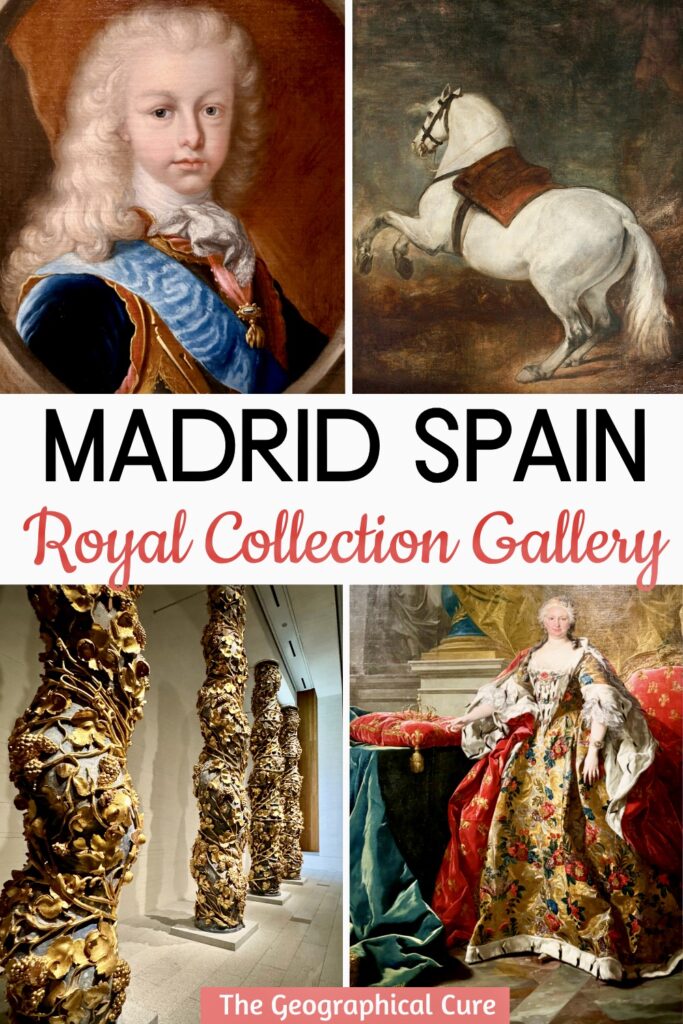The Royal Collection Gallery in Madrid opened its doors in July 2023. It was a long-awaited addition to the city’s cultural scene. I was thrilled to finally visit!
National Geographic hailed it as a top “cultural attraction” for 2024. It’s a haven for lovers of classic art in a modern setting.
Designed by architects Emilio Tuñón and Luis Moreno Mansilla, the gallery is housed in a state-of-the-art building. I can’t say I fancied the blocky exterior, which looks a bit like a prison. But the interior was pitch perfect for displaying art.
The RCG is a museum of fine art, decorative art, and historical artifacts. It reminded me a bit of the Victoria & Albert Museum in London.
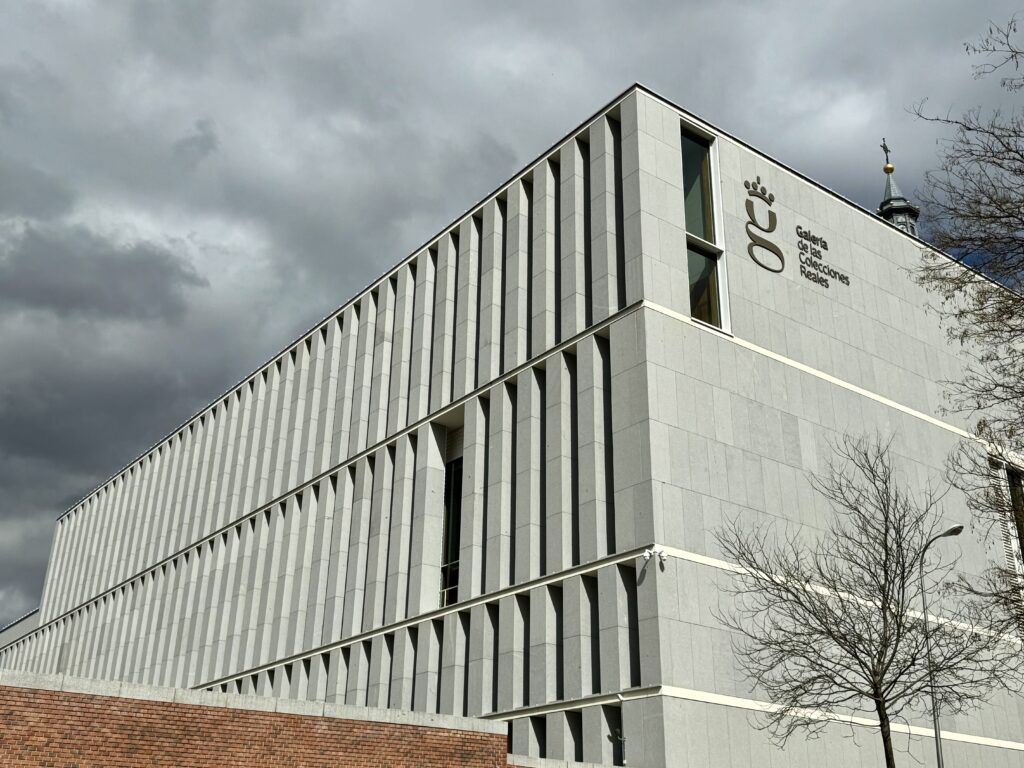
The gallery’s collection rivals that of the Royal Palace, but with more impressive paintings and fewer visitors. It also seemed like I was the only English speaker there, making it feel like an undiscovered treasure.
The museum’s exhibits bring the royal collection under one roof. They were drawn from 19 royal palaces and 10 monasteries under the National Heritage’s care. They span 500 years of Spain’s imperial history and artistic patronage.
Exhibits are organized in chronological order and spread across three floors:
- Floor -1: Hapsburg exhibits
- Floor -2: Bourbon exhibits
- Floor -3: temporary exhibitions
You’ll find an array of decorative items, paintings, portraits, tapestries, porcelain, royal carriages, altars, statuary, and rugs. The expansive halls are accessed via long stone ramps.
>>> Click here to pre-book a ticket
Who Were The Spanish Kings?
To understand this museum, you need a very short history of the Spanish royal family. After all, it’s their collection and you’ll see their portraits on your visit.
Spain as we know it was born when the so called “Catholic Monarchs,” Ferdinand and Isabella, were married in 1469. They promptly set about expelling the Moors and the Jews and exploring the ocean with Columbus.
In those days, foreign policy was conducted by marriages. So, they married their daughter Jauna off to Prince Philip “the Fair” of Austrian, a Hapsburg boy and heir to the Holy Roman Empire.
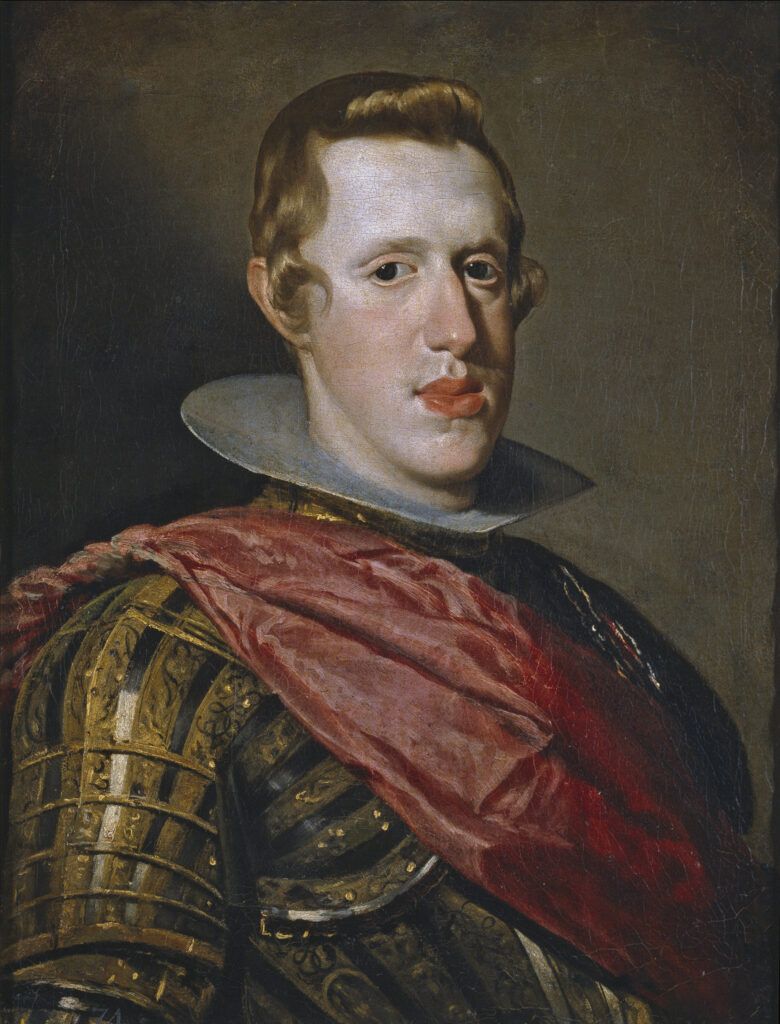
Juana and Philips’s son, Charles, eventually inherited all their kingdoms, making him the most powerful man in Europe.
He ruled as Charles I and was followed by Philip II, Philip III, Philip IV, and Charles II. Charles II was weakly and sick, likely a result of centuries of inbreeding.
He was unable to have children, and that ended the Hapsburg dynasty in Spain. He willed his kingdom to Philip of Anjou of France, the grandson of King Louis XIV.
In 1714, Philip V became the first king from the Bourbon dynasty. He got to work straightaway, building the Royal Palace.
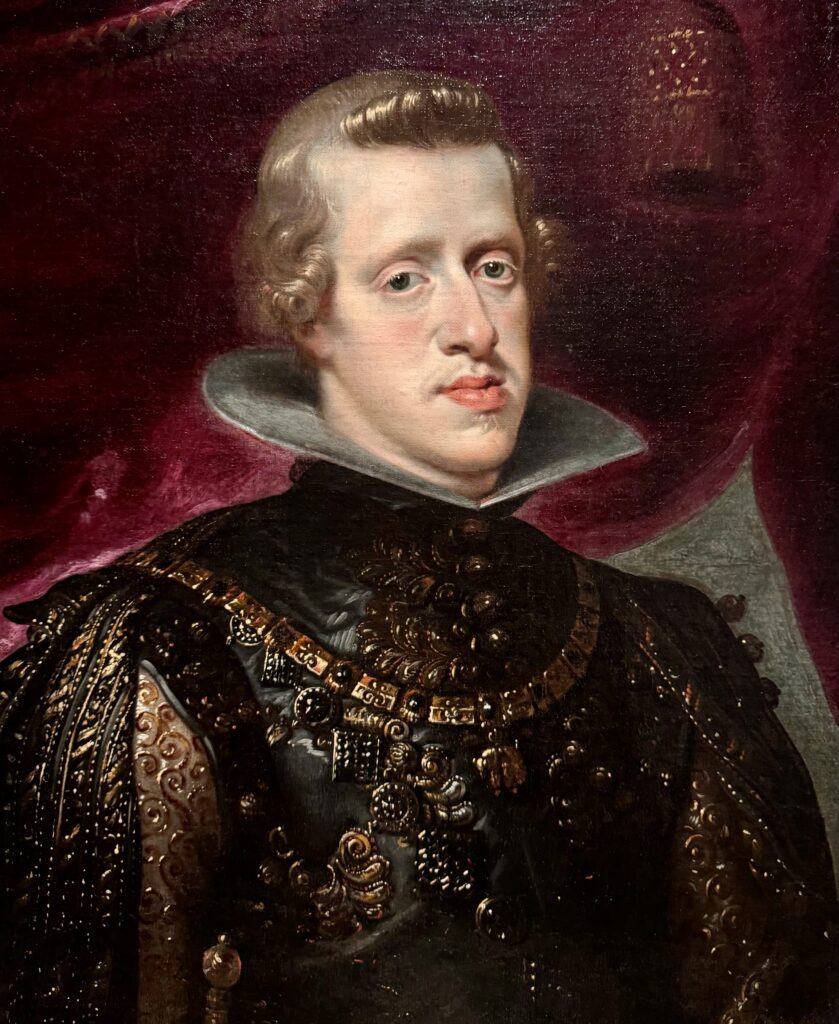
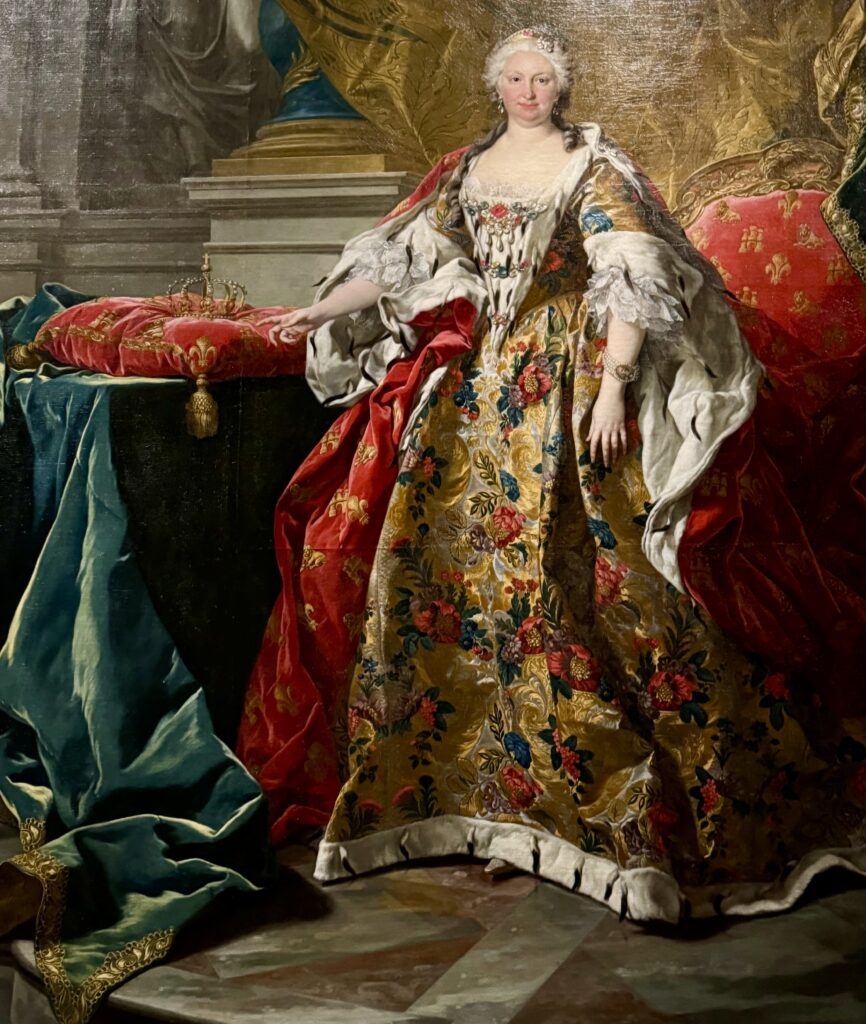
When Franco took power in 1931, he sidelined the royals. Today, Spain is a constitutional monarchy with a figurehead Bourbon king.
All the Spanish monarchs were known for their artistic patronage. But King Philip II and King Charles III are particularly notable for their contributions to the arts and culture.
Philip II commissioned works from prominent artists like Titian, El Greco, and Hieronymus Bosch. He loved the Italian and Flemish schools.
Charles II built the Prado Museum and supported artists like Goya, Mengs, and Tiepolo. His wife, Isabella Farnese, was also an avid art collector. She acquired Italian Renaissance and Baroque artworks.
Charles II’s royal factories and workshops also churned out lavish furniture, clocks, porcelain, decorative, textiles, garments, rugs, and tapestries for the king.
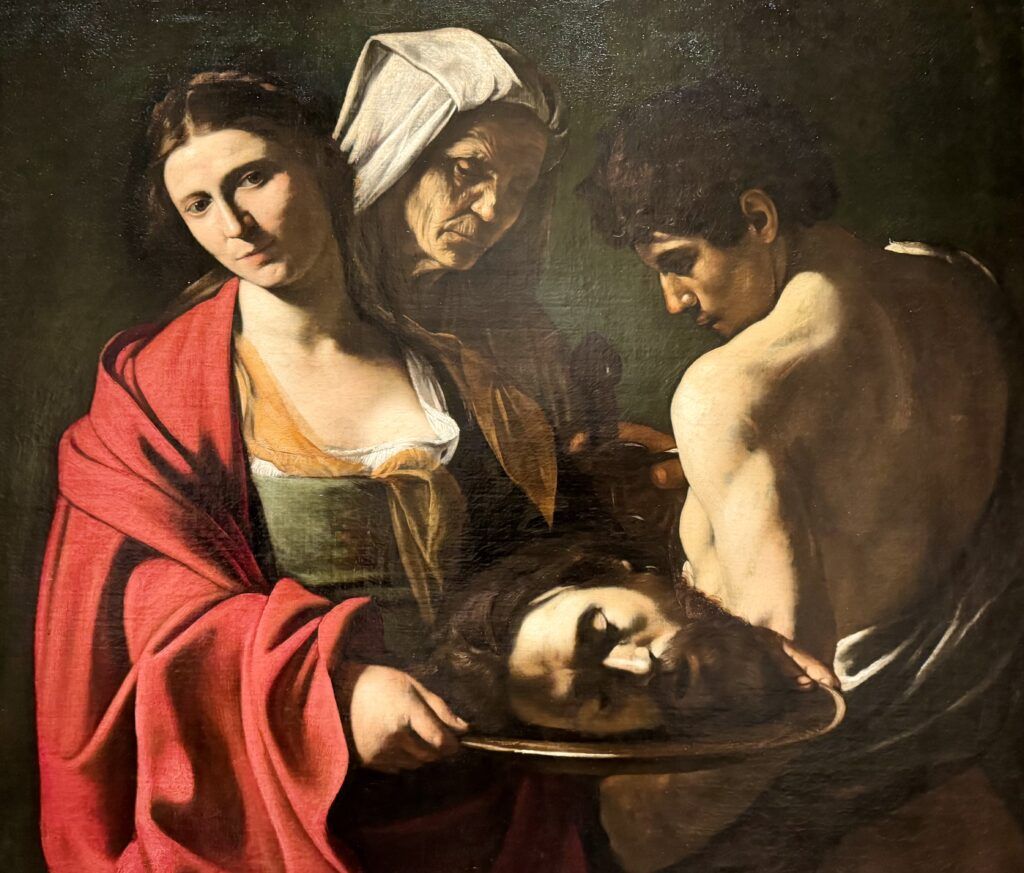
Guide To The Royal Collection Gallery: What To See
Here are some of the must see museum highlights.
Caravaggio’s Salome With the Head of John the Baptist
Caravaggio almost single-handedly pioneered the 17th century Italian Baroque style, leaving a lasting impact on the art world.
There are precious few of his paintings in Spain (only 4!). But one is in the RCG, Salome With the head of John the Baptist. Philip IV bought the work from the Viceroy of Naples.
This is a late Caravaggio, created when the artist had fled Rome for Naples. In this scene, as in so many of his artworks, the artist combines beauty and brutality.
Swathed in a blood red cloak, Salome looks quite indifferent as she holds the severed head of the saint. The executioner, on the other hand, seems to commiserate with the innocent victim.
The servant, an elderly lady, seems to be growing out of Salome’s neck, creating a wonderful contrast of youth and age.
READ: Life of Caravaggio
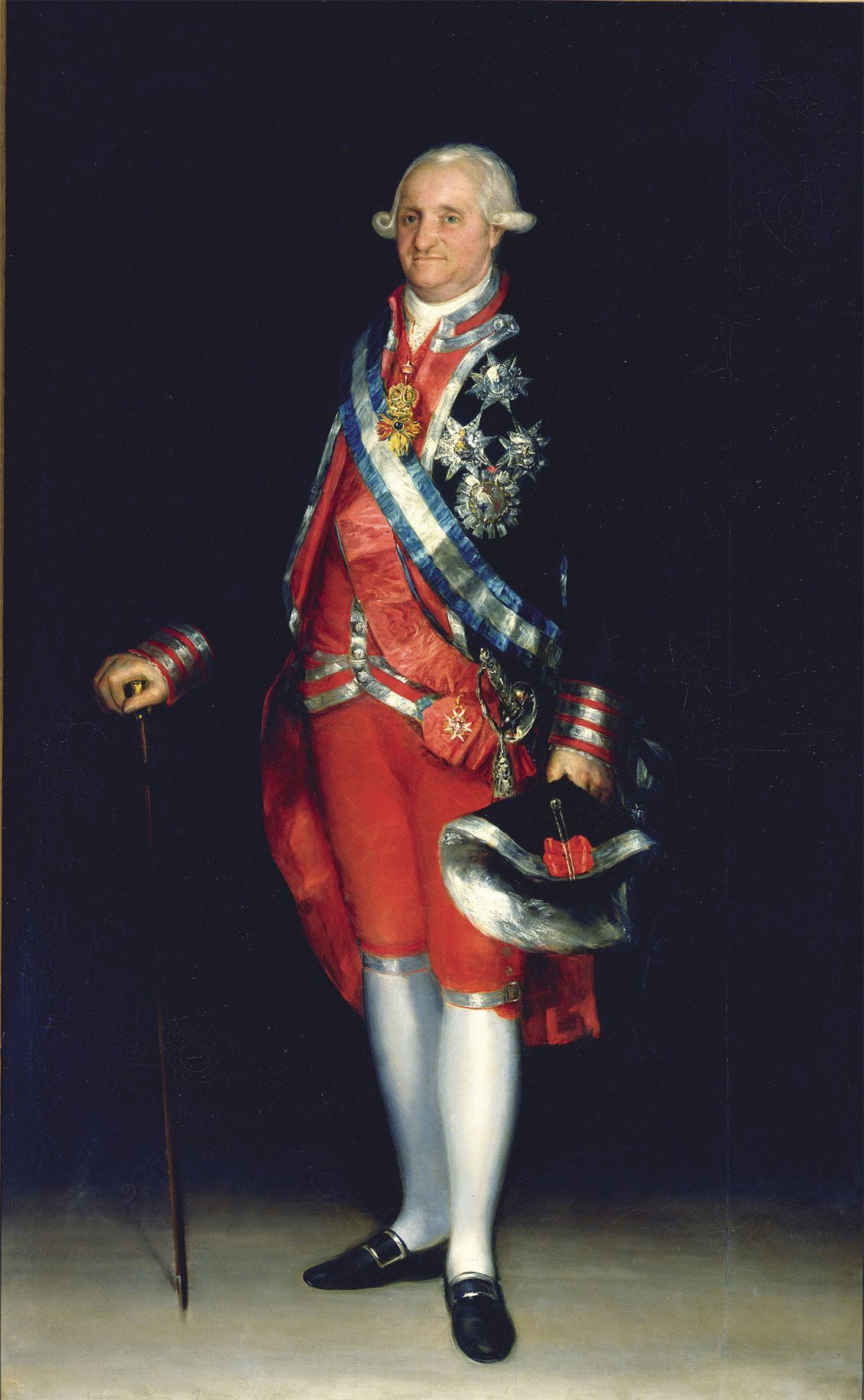
Goya’s Charles IV
Francisco de Goya was a towering figure in Spanish art. He’s celebrated for his profound observations of society and pioneering approach to painting.
As court painter, he painted many royal portraits, such as this one of Charles IV.
In this painting, Goya portrays the king in the resplendent uniform of a colonel, highlighting the majesty and authority of the monarch.
Yet, Goya also painted the king in a realistic way, without idealizing his appearance. This may subtly suggest the complexities beneath the surface of royal life or possibly be a subtle critique of the institution of the monarchy.
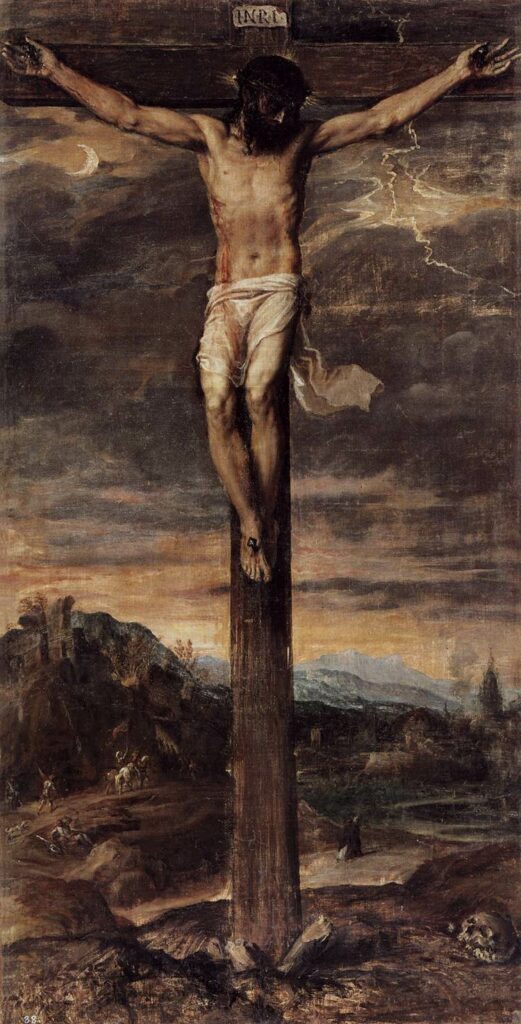
Titan’s Crucifixion
Titian was a Venetian master, celebrated for his revolutionary approach to color and composition. He’s known for his dynamic portraits, mythological scenes, and religious works.
Titian was a favorite of Philip II and regularly worked for him during the last three decades of his life.
In this painting, Titian eliminates any secondary figures and just portrays the heroic image of Christ. He’s isolated against a stormy sky, giving the painting an expressive beauty.
This painting was formerly in El Escorial. It fell from a wall and was ripped, necessitating repairs at the Prado.
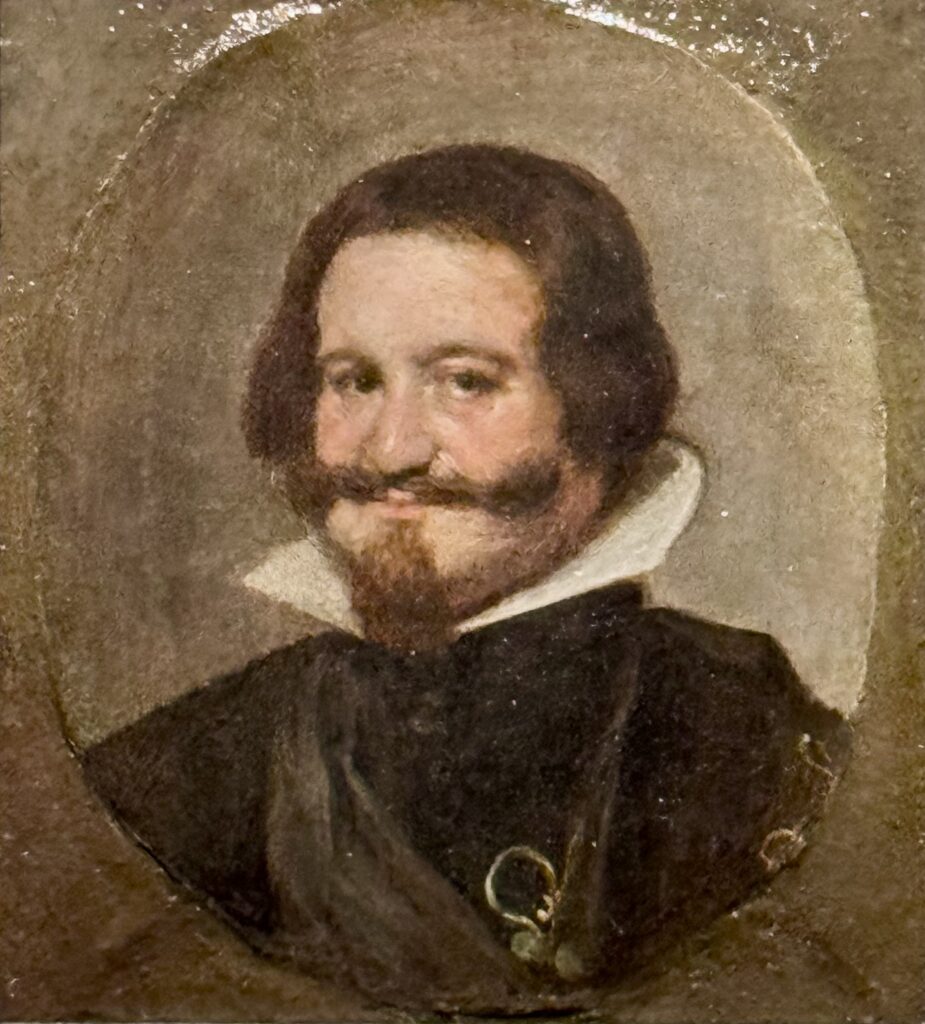
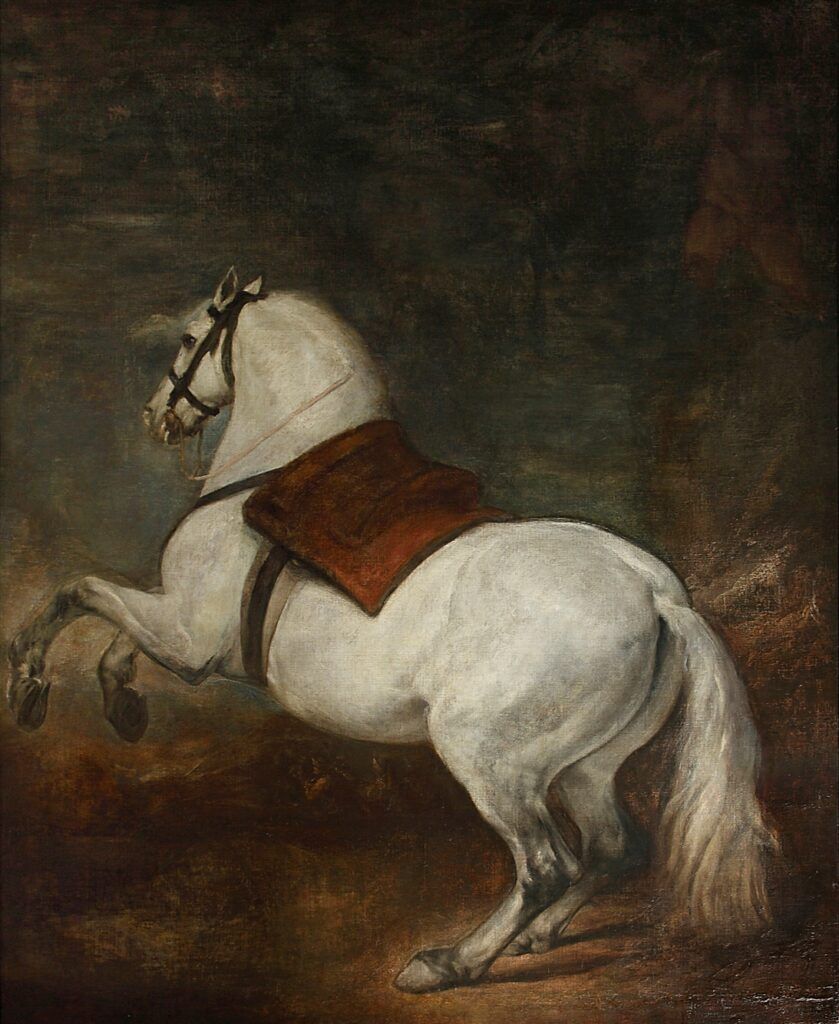
Velazquez Paintings
The RCG has a number of exquisite artworks by Diego Velázquez. He was a seminal figure of the Spanish Golden Age and court painter to Philip IV.
Known for his remarkable realism and intricate compositions, Velázquez has a unique ability to capture the very soul of his subjects.
Among his notable works, one large masterpiece from the 1630s dramatically presents a majestic white horse, rearing up without a rider. One wonders if Velázquez was just waiting to be told which king to put in the saddle …
In another piece, a miniature, he portrays the Count-Duke of Olivares, the king’s favored advisor. It has precision and intimacy that brings the historical figure to life, a peculiarity of the artist’s works.
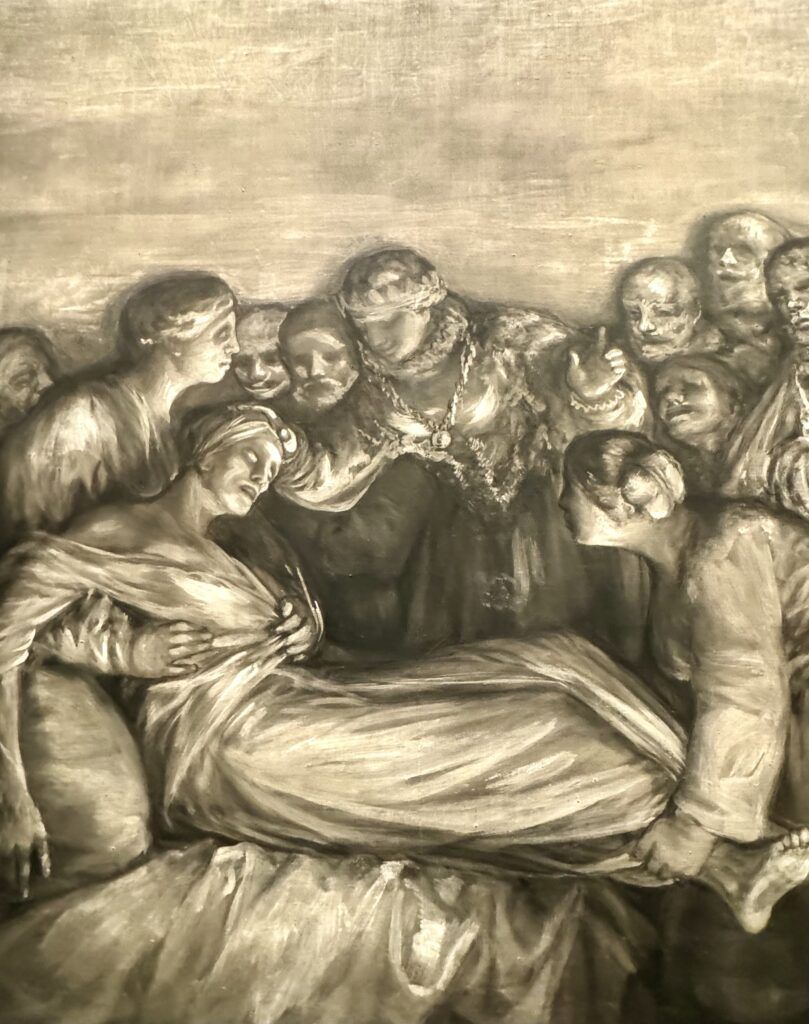
Goya Grisailles
The RCG has a series of Goya grisailles (monochromatic tones) made in 1816 by Goya and his workshop. The one above was executed by Goya alone.
They once adorned the dressing room of Queen Maria Isabel of Braganza. They were intended to extol the merits of the young ruler and prudent queen.
In this painting, she is portrayed as a model of virtue, giving comfort to a sick woman.
It was Goya’s last royal commission. It has a raw honesty and undeniably dramatic quality, with the black and white contrasts.
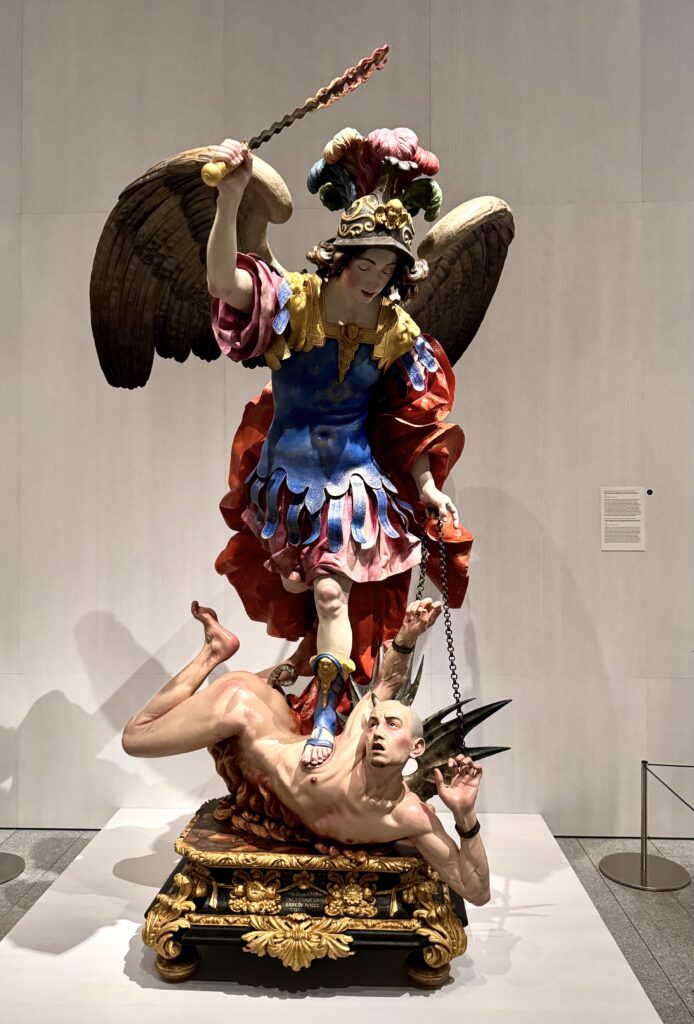
Luisa Roldán’s St. Michael Archangel Vanquishing the Devil
Luisa Roldán was a rare woman who cracked the glass ceiling in the Baroque era, along with the Italian artist Artemisia Gentileschi. In fact, she was the first woman appointed as a court sculptor, first by Charles II and then by Philip IV.
Roldán is known for her colorful compositions on religious themes. And you can’t possibly fail to notice her magnificent St. Michael the Archangel Defeating the Devil in the museum.
This work is part of series of processional sculptures made with polychrome fired clay or wood and “dressed.” This sculpture is one of her finest works, with amazing anatomical accuracy and a wonderful approach to composition.
In it, a distinctly feminine looking Michael brandishes a sword. Some art historians theorize that Michael’s face is Roldán and the devil is a likeness of her husband.
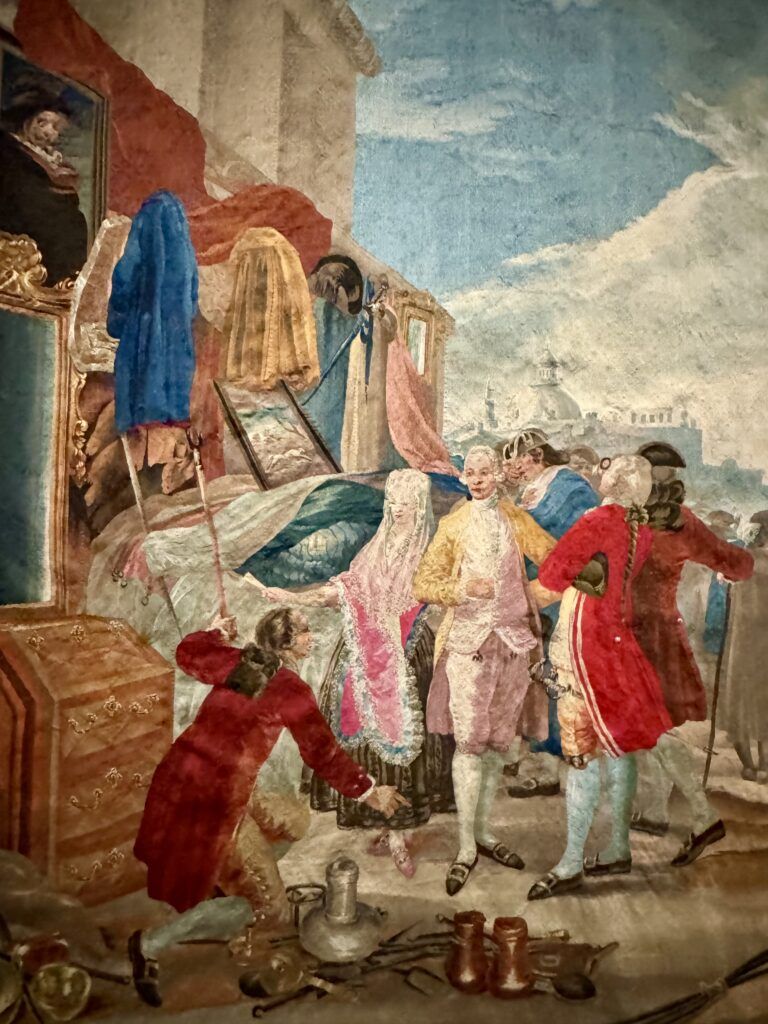
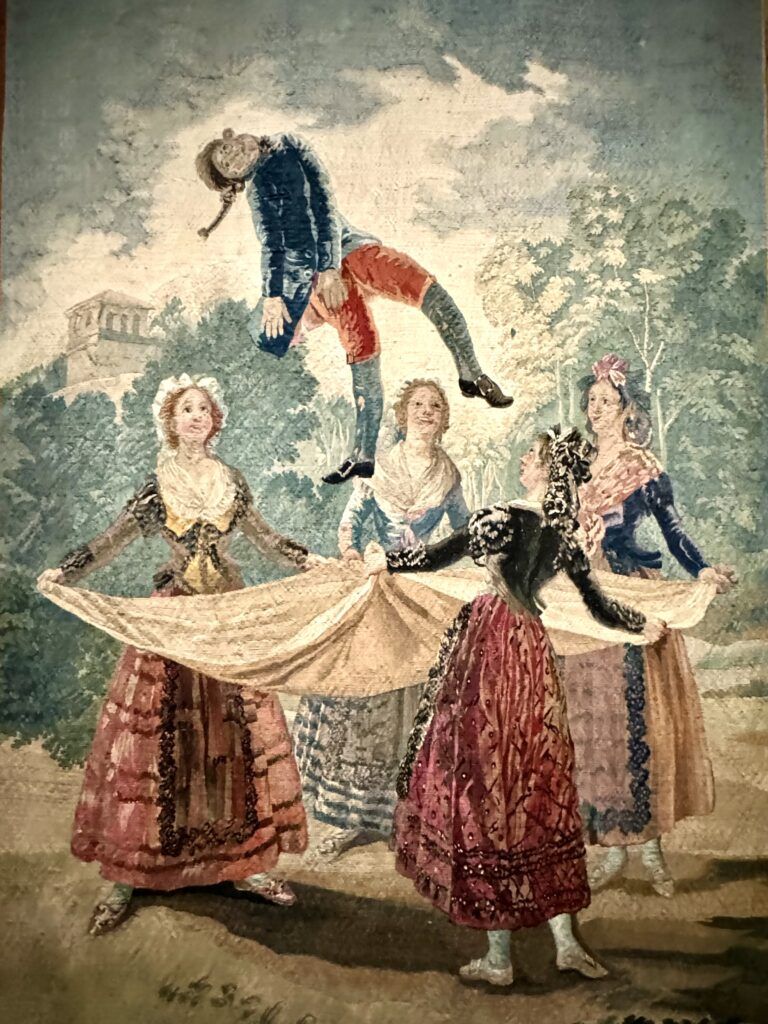
Tapestries Based On Cartoons
The RCG has a treasure trove of tapestries. They are based on cartoons (preparatory drawings) by some of the greatest old masters.
The cartoons by Goya (shown above) are based on fair themes. They were created for the bedchamber of the prince and princess of Asturias at the Royal Palace.
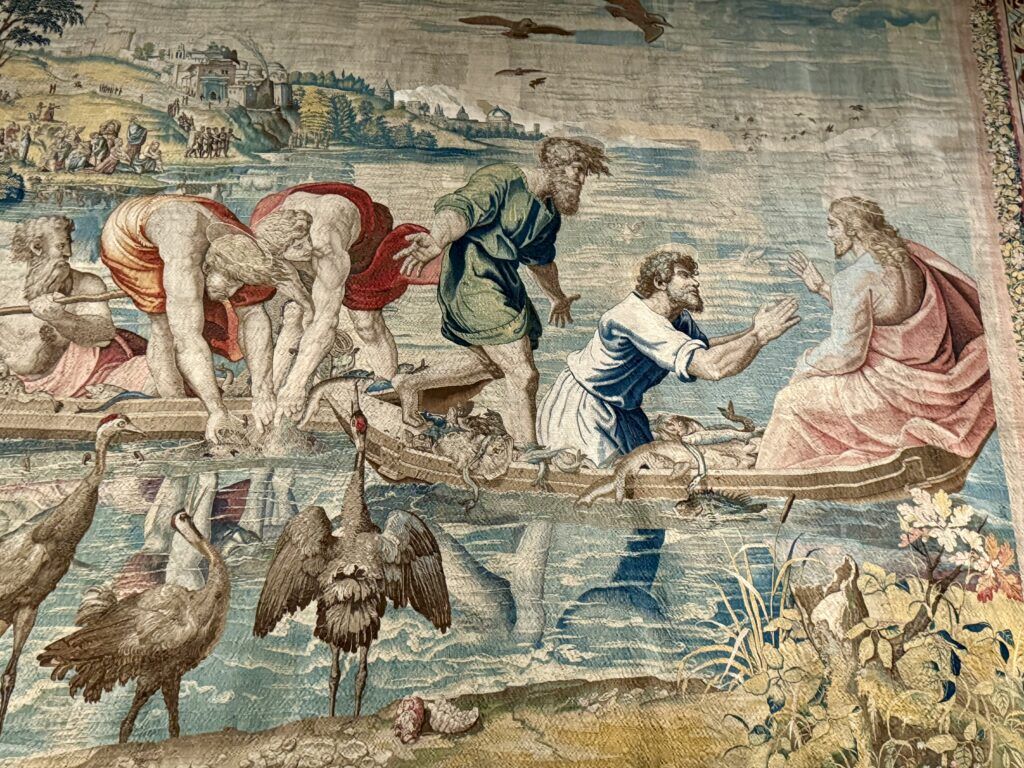
You’ll also find a tapestry based on a Raphael Cartoon, the Miraculous Draught of Fishes. This is the most famous tapestry from the collection.
It was commissioned by Pope Leo X for the Sistine Chapel. In it, a flock of hungry cranes watches men straining at a bulging net. A wild haired Peter kneels before Christ in the bow of a small ship brimming with fish.
You’ll also see a tapestry based on the most famous painting by Heironymous Bosch, The Garden of Earthly Delights, from the collection of Philip II. The cartoons were rendered by Bruegel the Elder.
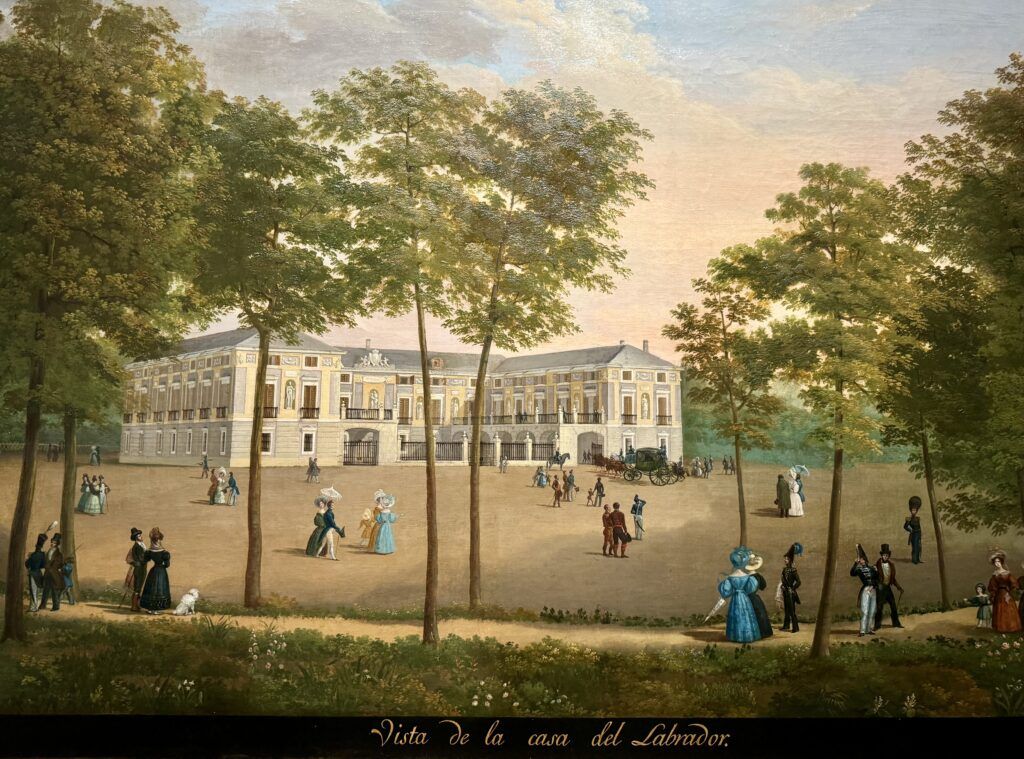
Fernando Brambila Paintings
I had never heard of Fernando Brambila before, but his works captured my attention.
Brambila is an Italian artist particularly noted for his involvement in the “Views of Spain” project commissioned by the Spanish Crown. Its aim was to document the country’s landscapes, monuments, and cultural heritage through art.
There are quite a number of his works in the museum. This one depicts the royal site of Aranjuez, a place designed solely to provide a distraction for the king.
This was where Ferdinand and his consort took leisurely strolls and enjoyed courtly amusements. Up close, the trees in the painting seem to shimmer and sparkle.
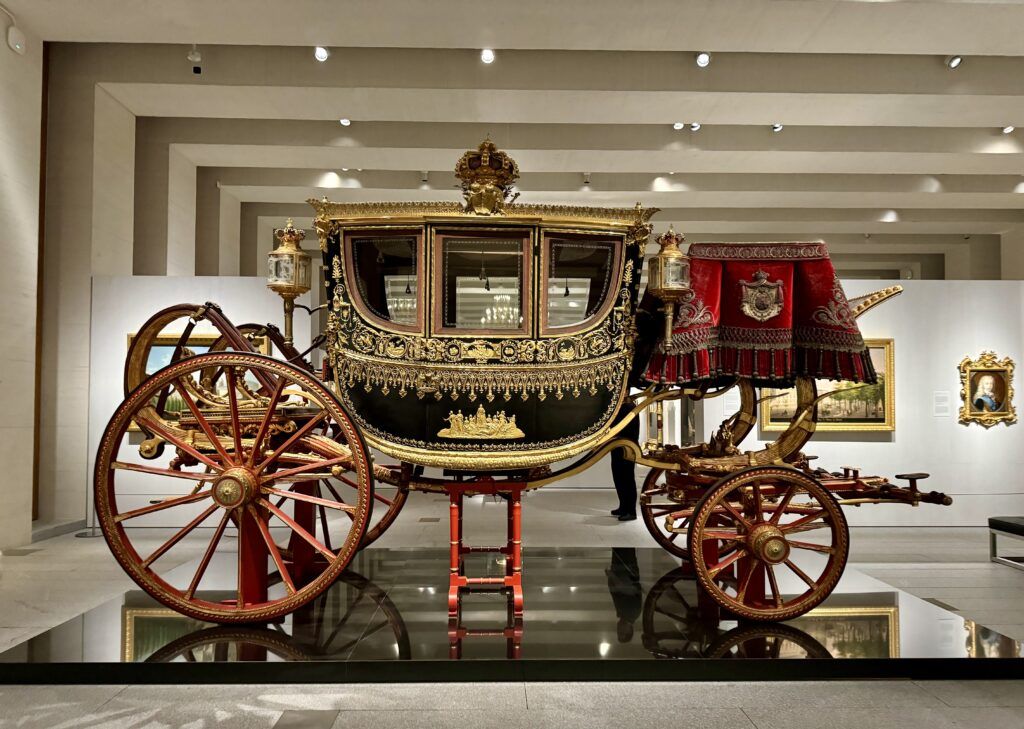
Royal Carriages
The museum had three carriages on display when I visited.
The lavish one shown above, the Grand Gala Carriage, was commissioned toward the end of Ferdinand II’s reign. It’s made of carved and lacquered wood, iron, gilded bronze, least, glass, velvet, and silver and gold trim.
There are mythological subjects and images alluding to the monarch’s virtues. On certain occasions, the driver’s seat was replaced with a carving of a lion with his paws resting on two globes.
The last Habsburg king, Charles II, is represented by his Black Carriage in ebonized walnut. It was an anticipation of his own funeral.
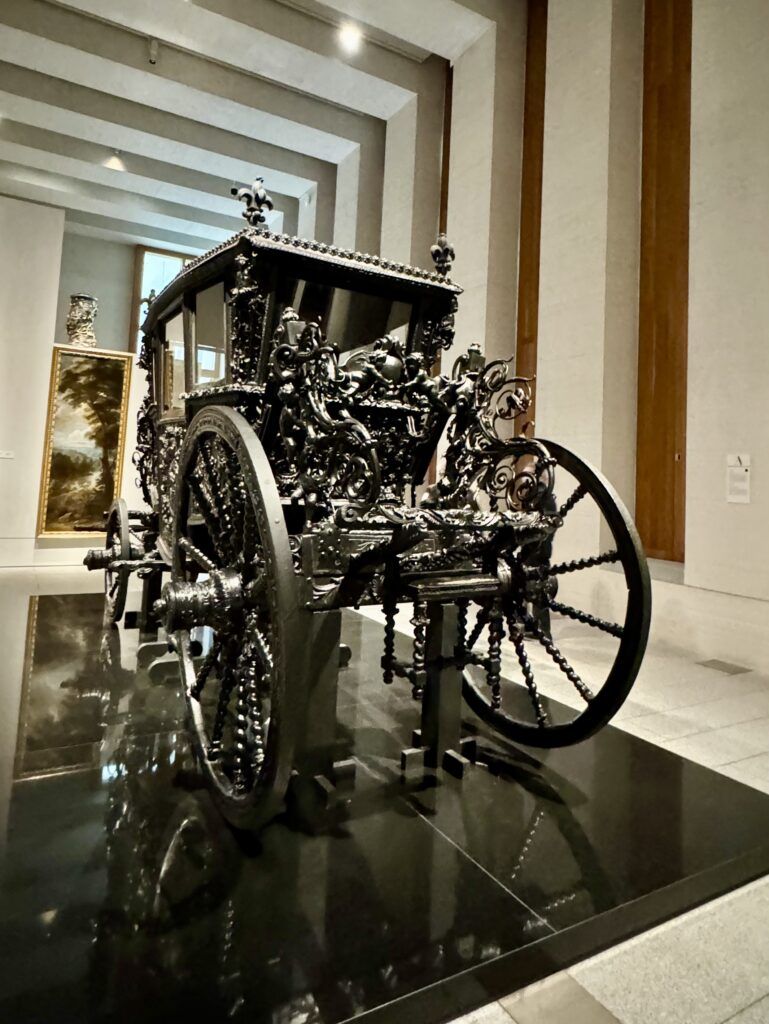
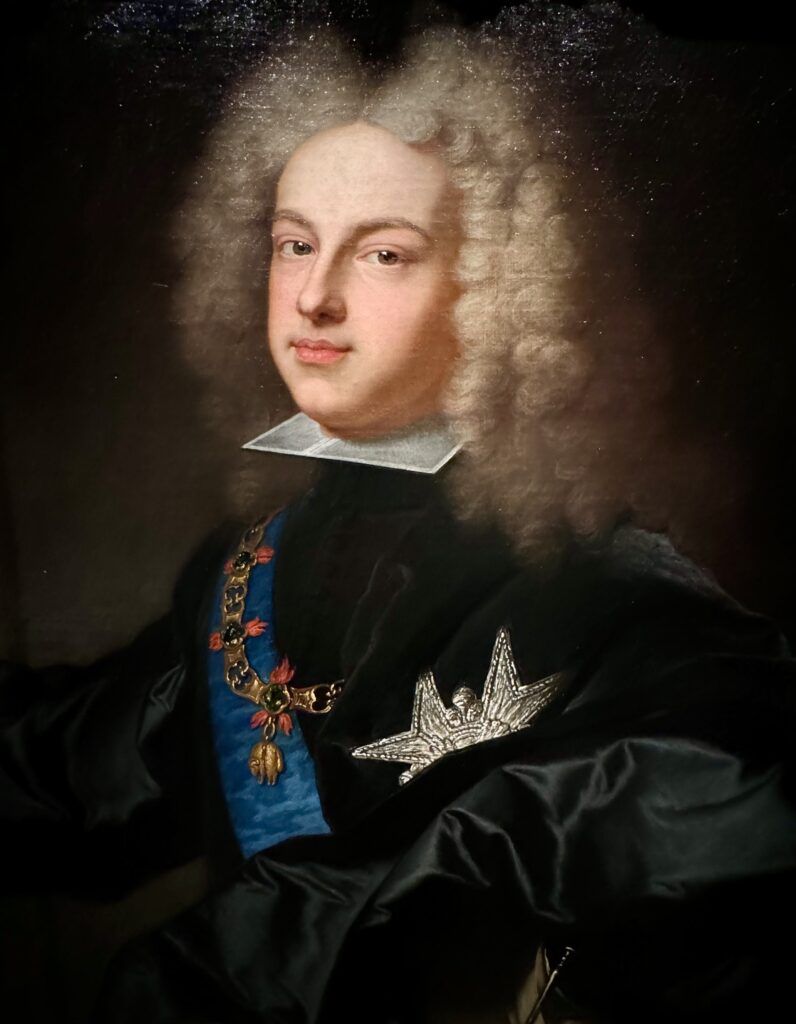
Rigaud’s Philip V in Spanish Costume
This canvas is by the French Baroque painter Hyacinthe Rigaud.
He’s best known for his grand and meticulously detailed portraits of Louis XIV and other members of the French aristocracy.
In this painting, the artist captures Philip V, Louis XIV’s grandson and the new king of Spain. A full length version of this painting is at Versailles.
With obvious propaganda intent, the young man is dressed in the Spanish fashion. He wears a suit of black satin and the blue sash representing the order of the Holy Cross.
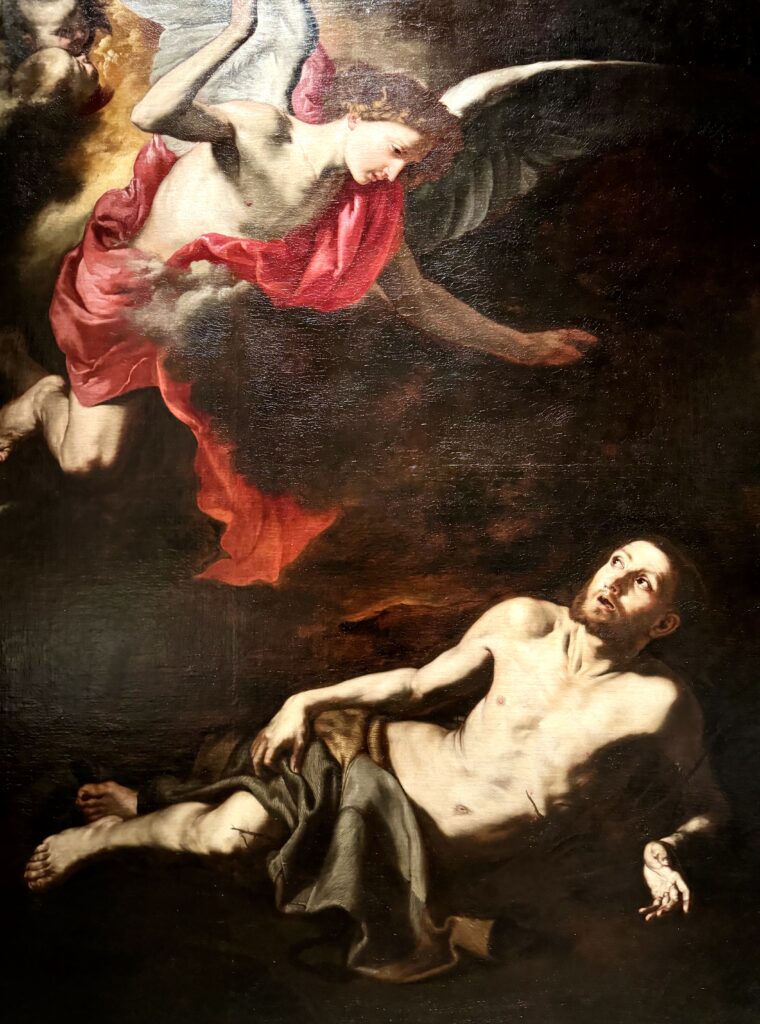
Ribera’s Saint Francis in the Thorn Bush
Jusepe de Ribera is a Spanish master of the Baroque period. Philip IV collected many of his works. But this painting was acquired by Isabella Farnese, then the queen dowager.
Ribera is renowned for his intensely emotional works and dramatic use of light and shadow. Ribera excelled in religious subjects and stark, realistic depictions of human figures.
In this painting, he depicts the moment when St. Francis threw himself into a thorn bush to escape being temped by the devil. Legend holds that the thorns turned into roses, and that event gave rise to the concept of plenary indulgences.
Often associated with the Tenebrism movement, you can see Ribera’s strong use of chiaroscuro (dark and light contrasts) that suggests the influence of Caravaggio.
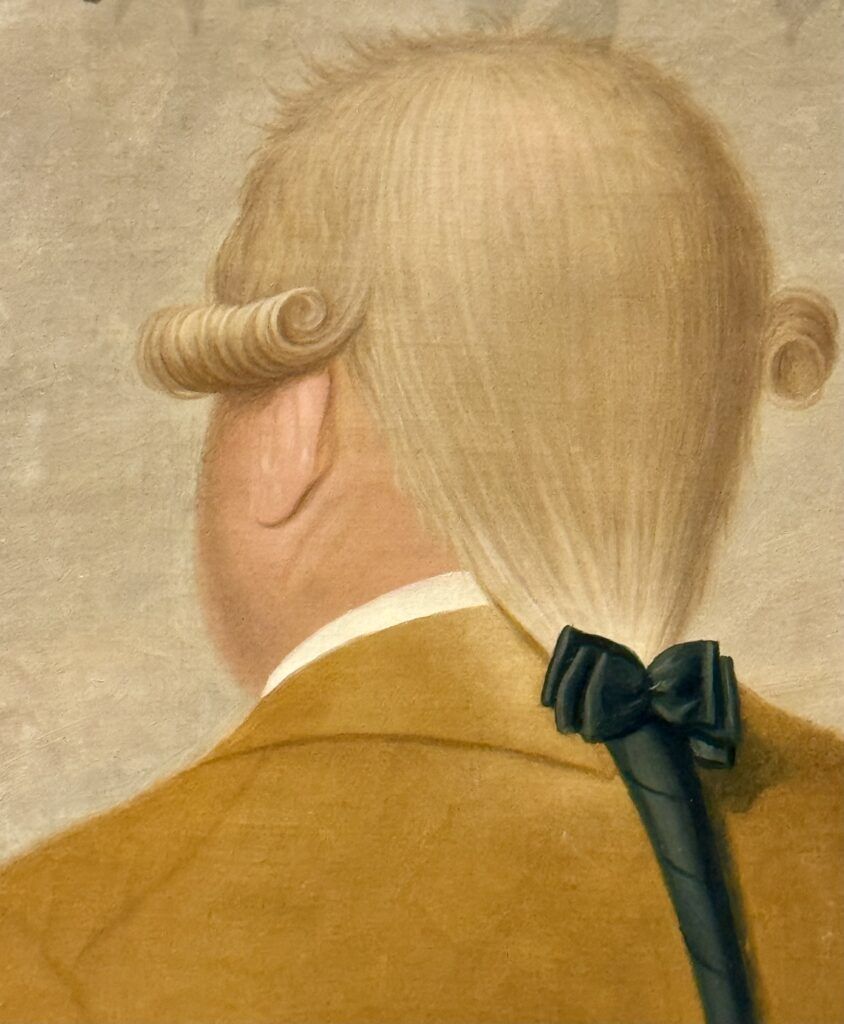
Bauzil’s Charles IV from Behind, 1818
I couldn’t help but laugh a bit at this painting. It’s so unusual.
It’s a depiction of Charles IV from behind, painted shortly before he died in 1819. Bauzil was a court painter and created many likenesses of the king.
Despite showing him from behind in a then unfashionable wig, his features are still recognizable. It recalls the famous portraits by Goya that made the Spanish monarch so familiar.
This highly original painting contributed to Queen Maria Luisa dubbing Bauzil the “mad painter.”
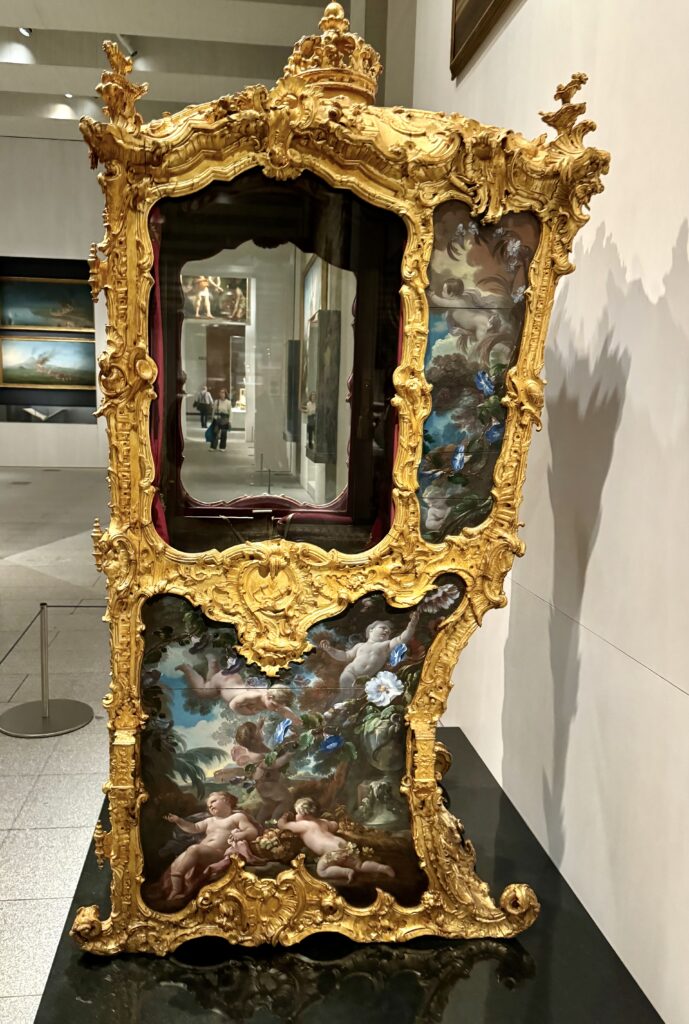
Sedan Chair
This gorgeous sedan chair belonged to Queen Barbara of Portugal. She used it to move about the royal estates.
The painted decoration and design are attributed to Corrado Giaquinto, the chief court painter of Ferdinand VI.
The painting on the panels is an ode to peace and harmony. Little putti are engaged in Dionysian romps and a glorifying scene on the back extols the queen.
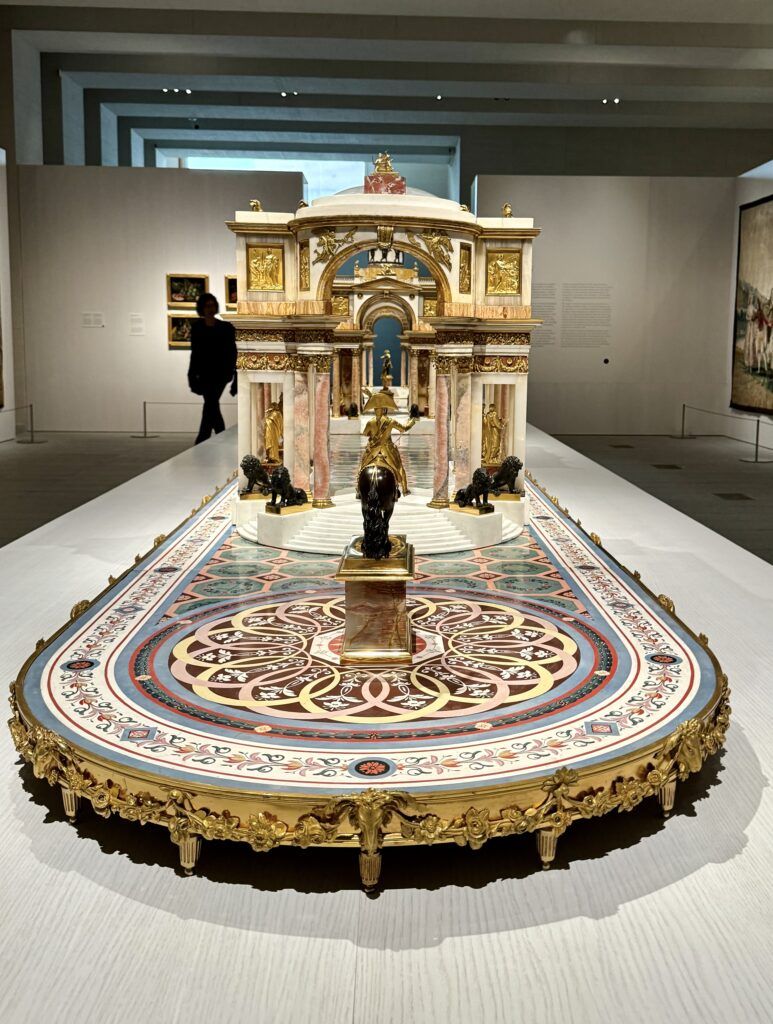
Ornamental Centerpiece
This elaborate centerpiece, a surtout de table, was made for the royal site of Aranjuez. It’s a massive piece made of marble, gilded and patinated bronze, stucco, and wood.
Bas reliefs narrate the history of Spain, its great men, and all the sovereigns. Most of the figurines are missing today.
But you can still see Charles III in the central temple, crowned by an allegorical figure of Spain. The mini equestrian statuettes of Charles IV and Prince Ferdinand also survived.
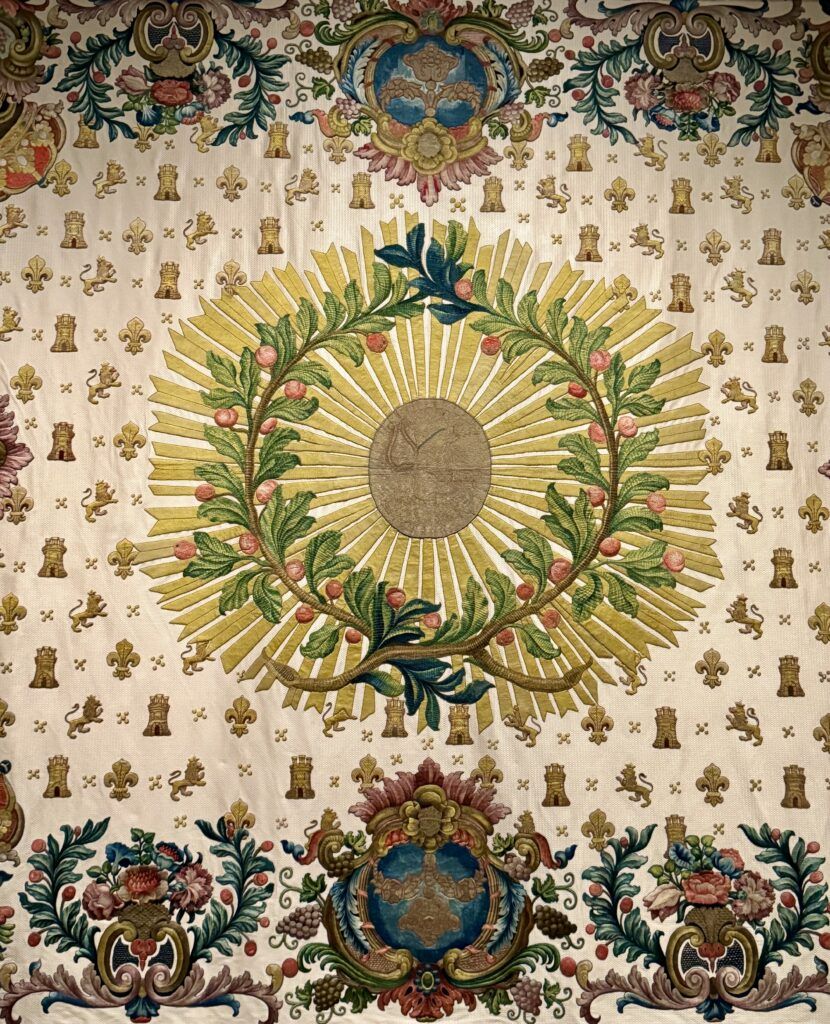
Carpet
There are plenty of beautiful carpets at the museum, but this one caught my eye for its uniqueness.
It was part of the vestments and accessories made for the chapel in the Royal Palace.
Like all the pieces, the background is filled with King Ferdinand’s emblems — castles, lions, and the Bourbon fleur-de-lis. In the corners, there are royal crowns and personifications of the four continents.
The haloed tondo in the center depicts King David, Jesus’ ancestor, singing psalms.
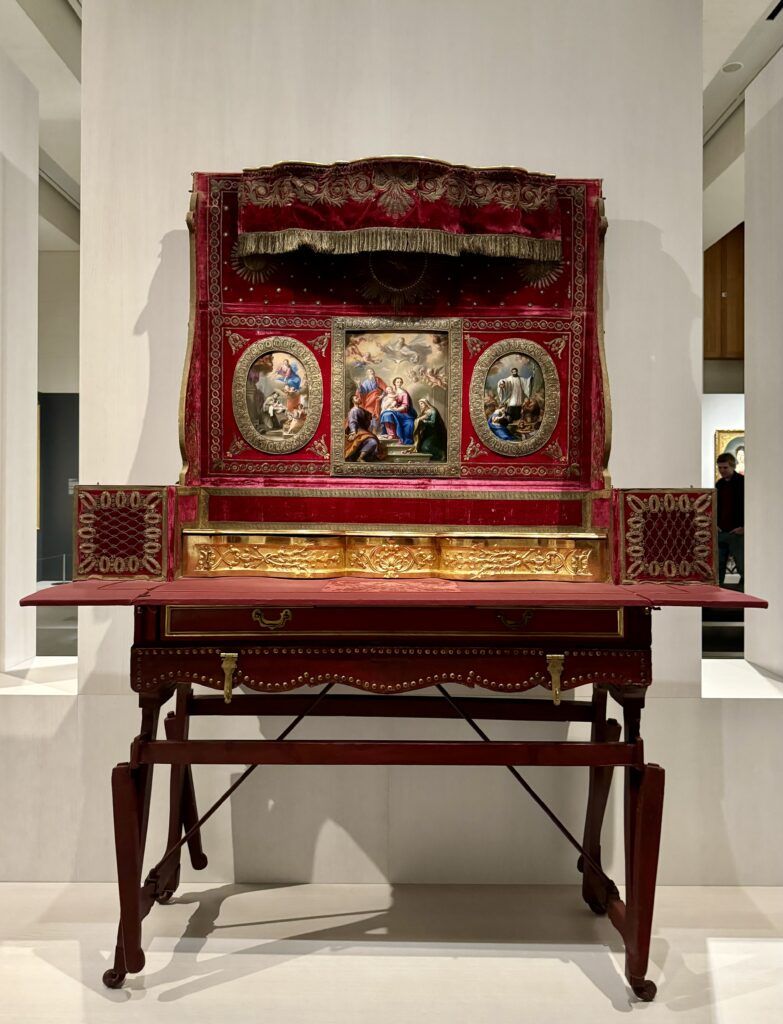
Portable Altarpiece
This is one of the oldest portable altarpieces in all of Spain. It dates from the reign of Philip V and was made for Ferdinand VI, when he was still prince of Asturias.
The chest-like folding altar is made of red leather, red velvet, and gilded decoration.
In the center are three oil paintings on copper by Andres de la Calleja. It was formerly in the Gasparini Room of the Royal Palace.
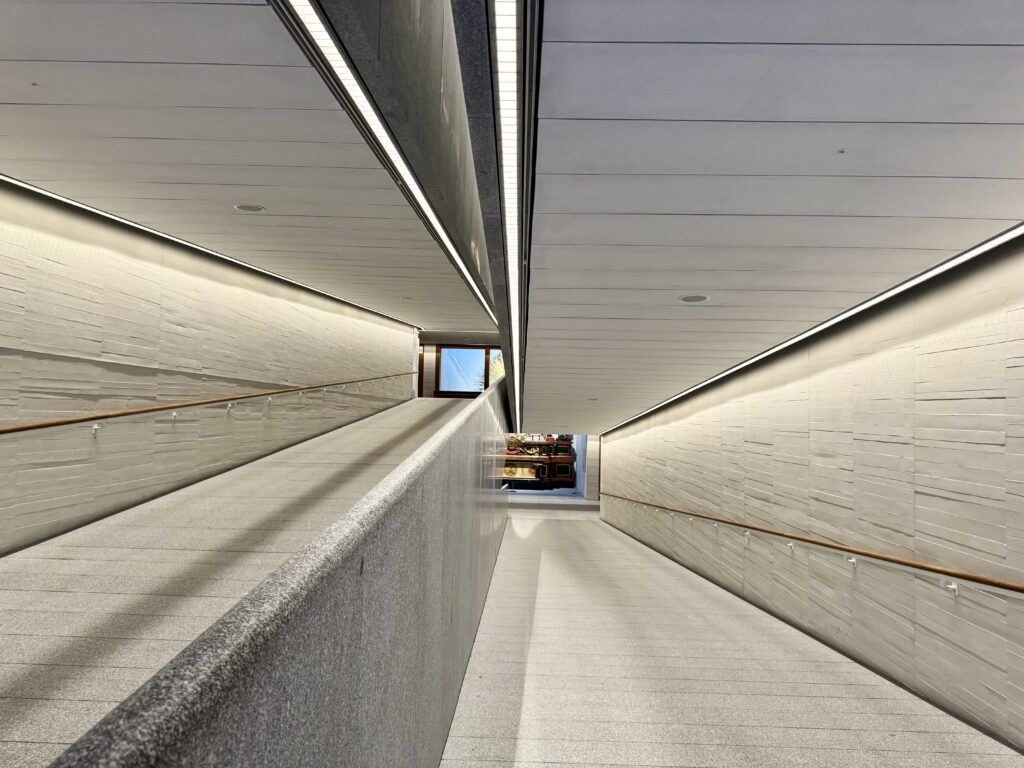
Practical Guide & Tips For The Royal Collection Gallery
Address: Calle de Bailen
I had a bit of difficulty finding the museum. But it combines well with a visit to Almudena Cathedral and the Royal Palace. The museum is to the right of the cathedral’s front facade. It’s set back, so you can’t see it right away.
Hours: Monday to Saturday from 10:00 am to 8:00pm. Sundays and public holidays from 10:00 am to 7:00 pm.
Tickets: 14.00 €
Pro Tips: Unlike the Royal Palace, you can take photos without a flash. You can check your bag or wear it in front.
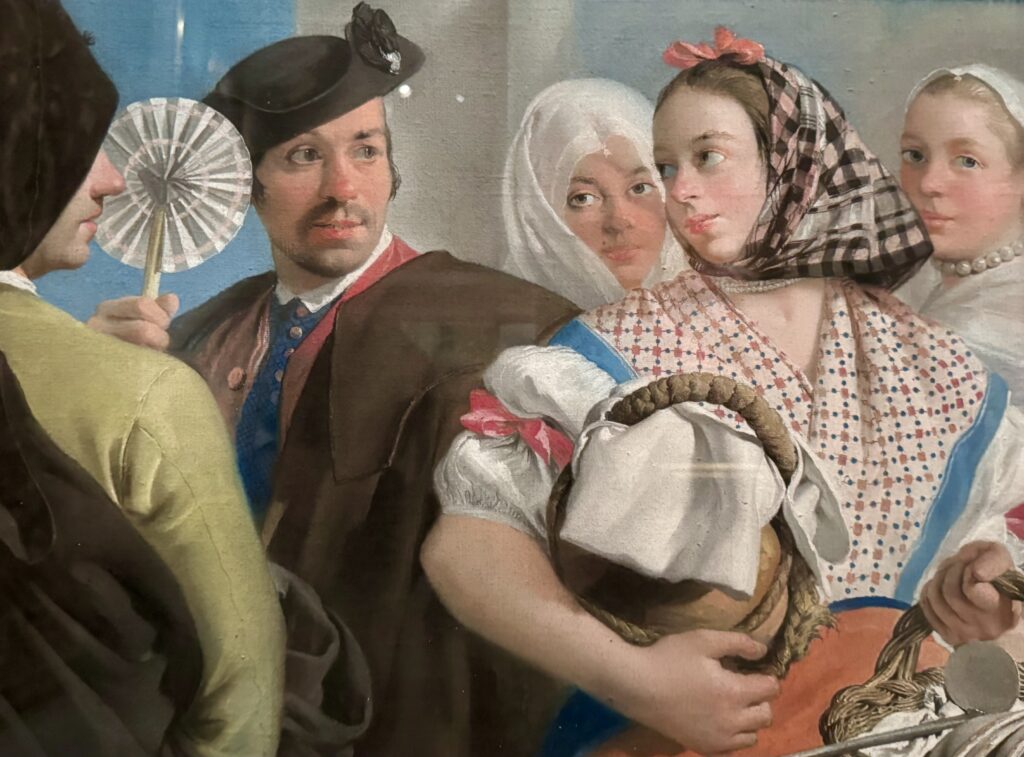
I hope you’ve enjoyed my guide to the Royal Collection Gallery. You may find these other Spain travel guides useful:
- 10-14 days in Spain itinerary
- 3 day itinerary for Barcelona
- 40+ Landmarks in Barcelona
- 33 secret towns in Spain
- 10 day itinerary for Andalusia
- Most Beautiful Towns in Andalusia
- 1 day itinerary for Seville
- 3 day itinerary for Seville
- 2 day itinerary for Madrid
- 2 day Itinerary for Bilbao
Pin it for later.

